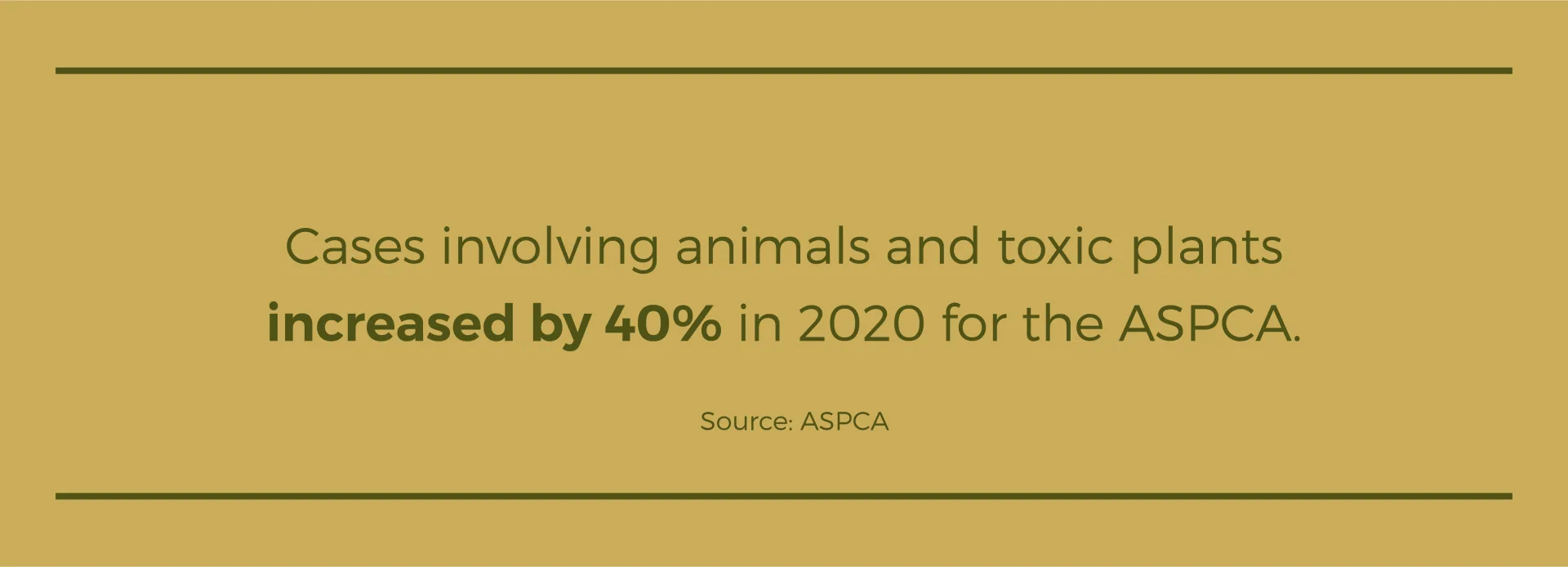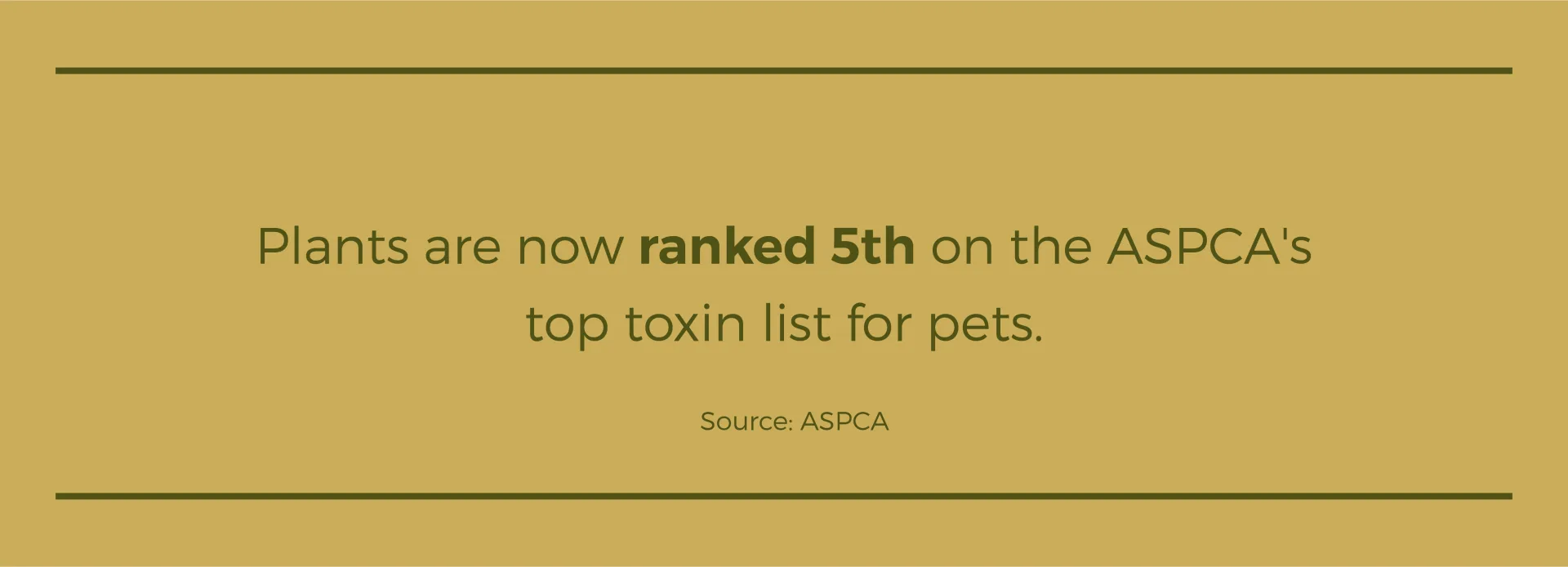June 22, 2018
Pet Safe & Friendly Plants for Cats & Dogs
When it comes to taking care of family, we at FTD know how important those furry members of our families are. They might not be blood, but they have a love and devotion that is unmatched. They’re there with us through thick and thin, and love us no matter what. So, it’s only right to make sure that we’re taking care of them properly and ensuring their safety at all times, just like they do for us. Part of doing our best for our pets is making sure we aren’t bringing any plants or flowers into our homes that can harm them or make them sick.
According to the ASPCA, plants now hold the fifth position on their top toxins list. That means it is crucial to be aware of what plants are pet safe and friendly, and which we should keep away from our furriest loved ones. It isn’t always easy to know which plants are pet-safe plants, so keep reading to educate yourself and take the first step toward protecting your four-legged family members.
What Are Pet-Safe Plants?
So, what exactly are pet-safe plants? They are plants that can be kept in your home or living spaces that will not risk the health of your cat or dog. Because pets tend to get into plants by chewing, digging, biting, etc., it’s important to know which are dog friendly plants, cat friendly plants, and overall pet-safe plants. And let it be known, that just because your pet doesn’t have a history of getting into your plants, that doesn’t mean they won’t get into them in the future, or that you should have plants in your home that only cause mild reactions for animals.
You still want to do your research to ensure that you’re only decorating your home with safe plants for cats or safe plants for dogs. You also want to be sure that you keep all greenery out of reach from your furry loved ones. Even if the plant isn’t known to harm a pet, that doesn’t mean it is 100% safe for yours. Like humans, each pet may react differently to plants and allergens.
By keeping your plants out of their reach, you are taking that extra step to keep them safe. There was a 40% increase in cases involving animals and toxic plants in 2020 for the ASPCA. So, the time is now to ensure you are doing your part in keeping your pets as safe as can be.
Toxic vs. Non-Toxic Plants
The difference between toxic and non-toxic plants is pretty simple, and there are three different degrees of measuring this.
Non-Toxic: There are some fully pet safe plants and are considered non-toxic. That means your pet can nibble on them, rub up against them, or consume them without having any major adverse reactions.
Slightly toxic: Then there are house plants that are slightly toxic. Those are the plants that would only require a large amount of the plant to be consumed to cause a major reaction. It’s best to keep your fur babies away from these.
Toxic: The worst plants to have around pets are those that are truly toxic. These are the plants that if nibbled, consumed, or tampered with, can cause extreme reactions for your pets. Plants can be toxic for different reasons and can cause a plethora of harsh reactions.
Some of the symptoms of toxic plants include:
Illness such as stomach pain, vomiting, or diarrhea
Severe illness or death
Rash or irritation
Breathing difficulties and throat swelling
Symptoms from possible ingestion include mild nausea to death caused by kidney failure or a number of different subsequent reactions. A few signs of potential toxicity include cold extremities, racing or irregular pulse, vomiting, lethargy, and rapid breathing. As a precaution, it’s strongly suggested that if you suspect your dog or cat may have nibbled a potentially toxic plant, you visit the vet immediately and bring a small sample of the plant that your dog or cat may have ingested. As you can see, knowing the difference between pet-friendly house plants and toxic ones, truly can be a matter of life or death for your fur babies.
The fact that The Animal Poison Control Center (APCC) saw 9,000 more plant-related calls in 2020 means that most pet owners don’t know the varying degrees of toxic to non-toxic house plants. This may be a case of thinking your plant is safe because it has never affected your dog, but is now harmful to your cat, and vice versa. Certain plants can be safe for one type of pet, but not the other, and knowing the difference is crucial.
Plants That Are Toxic for Pets
When it comes to picking pet-safe plants, you want to make sure you stay away from the majorly toxic and unsafe plants first. Then, once you have become familiar with those that are the worst for your pets, you will have a better starting point to find some that are safer and more reliable. So, which plants should you completely stay away from? Check out the lists below for some of the most toxic plants:
Top 10 Most Toxic Plants
1. Lilies—including calla, Easter, Oriental/Stargazer, and Peruvian (alstroemeria) varieties
2. Azaleas* and rhododendrons
3. Sago palms
4. Tulips
5. Hydrangeas*
6. Peace lilies
7. Devil’s ivy or pothos
8. Lantana
9. Daffodils
10. Hostas
Other Toxic Plants
Aloe vera
Autumn crocus*
Baby’s breath
Begonia
Chrysanthemum
Daffodil
Elephant’s ear
Foxglove*
Geranium
Japanese pieris*
Larkspur
Lupine
Morning glory
Oleander*
Poinsettia
Yew
The plants denoted with an asterisk (*) are cardiotoxic and pose the highest risk to pets. Avoid these plants in your home and always cross-reference a full list of toxic and non-toxic plants, such as ASPCA’s Toxic and Non-Toxic Plant searchable database. Even though this seems like a pretty detailed list, this is not an exhaustive list of every toxic plant. It’s vital for the safety and health of your pet to research each and every plant you bring into your home or yard. When you do the research, you are being a responsible and caring pet owner.
Safe Plants for Cats & Dogs
Now that you know which plants to steer clear from, we want to be sure to share with you which potted plants are safe for every member of your family, that way you can decorate your home with life, nature, and beautiful greenery!
African Violet
Because of their ability to bloom in low light and since they thrive in moderate temperatures and average humidity, African violets (Saintpaulia) make for a popular flowering houseplant among pet-loving households. A soil-free potting mix and a balanced fertilizer will help your pet-safe violet grow best.
Areca Palm
An areca palm, also known as a butterfly palm, grows up to five feet tall and has big, bold fronds. Those fronds can trigger a cat’s playful side, so it is comforting to know that they aren’t toxic for cats and dogs. Place your palm in a bright room and allow the soil to dry between watering, for a healthy, happy plant.
Baby Tears
The Soleirolia soleirolii’s dripping tendrils seem to have been created to attract cats. No matter how high up you place these enticing tiny green leaves, your furry pal is going to be drawn to it. Thankfully they are safe and non-toxic for your cats and dogs. Baby tears is not only a good choice when it comes to cat-friendly plants, but it’s also a great idea if you’re just starting to harness your green thumb.
Banana Tree
Banana trees are a pet-safe plant, bold, and make a statement, just like its toxic friend the weeping fig. Rich soil, regular watering, and bright light will make your banana plant flourishing in no time.
Bamboo Trees
Some bamboo trees, like those that we offer at FTD, are safe to the touch for your pets, but should be kept away from them as best as possible. Because of their size, some pets may find that they want to consume them and take a nibble. By putting your bamboo high on a shelf or in a room where the pets aren’t allowed, makes it so there is no chance or potential for any unsafe happenings.
Boston Fern
Boston ferns (Nephrolepis) are a long-lasting, enduring, pet-friendly house plant. Their shaggy foliage is non-toxic to cats and dogs, and super tempting for them to take a nibble. Be sure that wherever you place your Boston fern, that it will get bright indirect light and some humidity. Your guest bathroom might be the perfect spot!
Bromeliad
The curiously cone-shaped blossoms, and strappy leaves of the bromeliad (Bromeliaceae), make for a crowd-pleasing, unique take on a house plant. These dog-friendly plants are easy to maintain, as they only need a bright window and a humid environment.
Calathea
Calathea plants are also known as peacock plants or zebra plants, because they possess large tropical leaves with exquisite stripes and stippling. Just be sure to give this cat- and dog-friendly plant some shade, as too much light can cause those beautiful leaves to lose their shine and color.
Christmas Cactus
“Christmas cactus” is the name given to the Schlumbergera family of cacti. Their rainbow of colors is non-toxic and poses no threat to your pets.
Friendship Plant
The friendship plant is adorned with fragile stems and intricately patterned leaves that are soft to the touch and pet-friendly. This pet-safe plant does well in low light and high humidity.
Gloxinia
Gloxinia (sinningia speciosa) plants make a great gift plant because they are beautiful and safe for cats and dogs. Provide it somewhere with indirect light and constant moisture for it to bloom to its fullest potential.
Haworthia
The haworthia is a succulent that’s easy to care for and provides good vibes to any space it resides in. Bright light and weekly water will keep this succulent in tip-top shape, all while keeping your pets safe in its company.
Money Trees
The pachira insignis is a hardy, easy-to-grow plant that is safe for all of your furry friends. Plus, if you are a notorious over-waterer, money trees are resilient enough to handle even the heaviest watering hand.
Mosaic Plant
The Fittonia albivenis is considered a nerve plant, which sounds like it might be deadly to animals, but its white and pink veining on its leaves is non-toxic, and safe for both dogs and cats.
Peperomia
The Peperomia species is diverse in color and textures, making them a popular houseplant. These non-toxic beauties look great in a hanging basket, and will be safe if you forget to water them occasionally.
Phalaenopsis Orchid
The Phalaenopsis orchid is one that is safe for cats and dogs alike. Though not all orchids should be consumed by your pets, the Phalaenopsis orchid can be nibbled on without harming your furry friends.
Polka Dot Palm
This palm can grow up to three feet outdoors when it is natively grown in Madagascar. In a pot inside your home it can reach up to 10 inches, making it a great decorative element for a pop of color in your space.
Ponytail Palm
Beaucarnea recurvata, a.k.a the ponytail palm, has tons of character and potential, and your pets are going to want to become friends with it. Its swat-able leaves are non-toxic and this pet-safe plant thrives in bright light, and grows best with low water.
Roses
When it comes to landscaping or adding a solid flower bush to the inside of your home, rose plants are a good choice. They are not only non-toxic, but they are a beautiful addition to any home or space. Just remember that though the leaves and petals are non-toxic and roses are pet safe plants, you’ll want to be wary of their thorns.
Royal Velvet Plant
Though royal velvet plants look like something from a psychedelic garden, they are safe and non-toxic to humans and animals. They are susceptible to root rot though, so you’ll want to water only when the soil is dry and thirsty.
Spider Plant
The spider plant is a timeless houseplant that is a safe plant for cats and dogs, and makes for a great addition to your home. It tolerates a wide range of light and soil conditions, so it’s safe for new plant owners and brand-new green thumbs.
Sunflowers
Sunflowers are not only a popular choice for humans, but also for animals, as they are attracted to their shape, seeds, and petals. No harm will befall your cats and dogs if they consume them, but do keep in mind that any sort of excessive plant consumption isn’t good for pets.
Swedish Ivy
Swedish ivy is known as the Creeping Charlie, and it isn’t a true member of the ivy family. That means it is a pet friendly house plant, and is non-toxic for your kitties and puppies.
Venus Fly Trap
The pet-friendly Venus fly trap is non-toxic and low maintenance. While your cats and dogs are safe from this plant, if you have pet flies they, of course, aren’t. The flytrap needs only one or two insects per month to sustain life, so not only does it add spice to your space, it helps keep it free of pests, too.
Shopping for a friend who happens to be a pet parent? Gifting flowers or plants is a great way to show someone you care and that you want to provide them with a natural gift to liven up their space.
Are There Benefits to Having Pet-Safe Plants at Home?
There are quite a few benefits to having pet-safe plants in your home, not just for pets, but also for humans. They help to purify the air, improve the mood of the environment, are visually stimulating, and add a natural feel to any space they are a part of. Once you have run out of space inside for more pet-friendly house plants, it’s time to move on to gardening plants.
Your Plants and Pets Can Coexist
We hope that if you thought you were going to have to drop all your plants because you just got a kitten or a puppy, that you realize they can coexist very easily. Just remember that, like pets, each green addition requires its own house plant care. When your plants are growing their best, everyone in the house (furry or not) will feel better, breathe better, and enjoy their time inside more.
So, whether you’re focused on keeping your current pets safe, or trying to prepare your home for a future pet, be sure to explore what we have to offer and purchase house plants from FTD.








